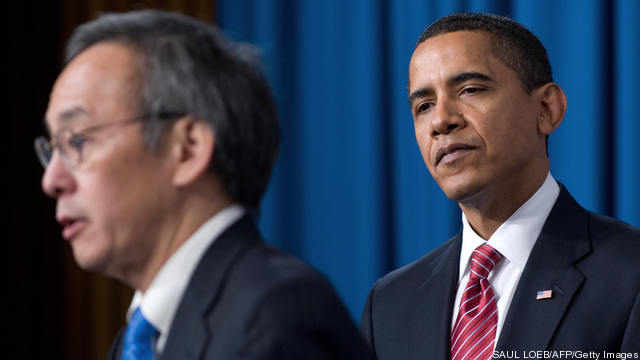
Energy politics have been more partisan than ever this year.
Republicans have been consistently supporting incumbent fossil fuel electricity generators–nuclear, coal and natural gas–while Democrats have been vocally supporting emissions regulations, renewables loan guarantees and tax incentives as well as increased taxes on oil and gas companies.
President Obama has been treading cautiously between the two parties, claiming he is putting White House money behind renewables while continuing to issue offshore drilling permits, delaying this September the EPA’s Ozone National Ambient Air Quality Standards until a scheduled review in 2013, asking the State Department to wait till next year to decide on the construction of the controversial Keystone XL pipeline, and allowing a host of renewables tax credits to expire at the end of this year.
Several notable issues have become talking points for the two sides, each combining superficial analysis with overused talking points to accuse the other side of a corrupted approach to the industry.
Emissions Regulations
Democrats have publicly defended the Cross-State Air Pollution Rule, an EPA regulation that requires 27 states to make significant cuts in power-plant sulfur and nitrogen oxide emissions that contribute to ozone and fine-particle pollution in other states.
Republican Senator Rand Paul of Kentucky sought to defeat the rule in early November with a Congressional resolution that represented a vote of “no confidence” in EPA regulation. Senator Tom Carper of Delaware and other Democrats urged defeat of the resolution, saying that failing to implement the Cross-State rule would boost both air pollution and health-care costs in states that lie downwind of Midwest power plants.
The resolution is now stuck in Congressional deadlock which means that the EPA’s Cross-State Air Pollution Rule (CSAPR) and the Mercury & Air Toxics Standards (known as the Utility Maximum Achievable Control Technology, or MACT, rule) are likely to be passed.
But some 45 plaintiffs–mainly upwind state governments and power companies–are alleging irreparable harm if the rule takes effect January 1, 2012 as scheduled. They say complying in 2012 may mean shutting facilities and risking power shortages. They want a federal court to delay the rule while its legality is litigated.
Although the regulations have been pending since the 1990 Clean Air Act amendments, they were not passed under President Bush. While Obama may eventually succeed in passing them, political wrangling has left its mark on the impending emissions regulations.
Solyndra Bankruptcy
No incident has been more damaging to the renewables industry in politics this year than the Solyndra bankruptcy this August. Republicans immediately jumped on the Department of Energy Loan Program Office that has divvied out billions in loan guarantees to renewable energy companies over the last few years making solar a dirty word.
Solyndra received a $535 million loan guarantee on March 20, 2009 to construct its Fremont, California copper, indium, gallium, selenium (CIGS) solar cell manufacturing facility.
But Democrats pointed out that the Bush administration initially provided the conditional commitment for the loan guarantee back in 2007. Indeed in January 2009, the Bush Administration moved swiftly on the Solyndra loan, taking it before a DOE credit review committee before President Obama was inaugurated.
Republicans blame the Obama administration anyhow, claiming that the February 2011 restructuring of the loan, which provided investors an additional $75 million because of a liquidity crisis, was problematic and a further drain of taxpayer dollars.
Under fire, Obama announced in late October that all DOE loans would be subject to independent review although he has repeatedly defended the program and its potential to help the US compete in the global renewables race.
Hearing on the Solyndra bankruptcy are ongoing with groups like the Republican-led Oversight and Investigations Subcommittee of the Energy and Commerce Committee conducting reviews of the matter. Many say the politicization of the bankruptcy will make it harder than ever for the government to approve loan guarantees for renewables in the future.
Keystone XL Pipeline
When TransCanada proposed a 1,700-kilometer pipeline that would transport 700,000 barrels of oil a day from Alberta’s oil sands to the Gulf Coast in Texas it did not anticipate the vehement environmental backlash within the United States.
Initially planned to pass under the Nebraska Sand Hills and the Ogallala Aquifer, the pipeline was seen as potentially catastrophic by Nebraska’s governor. This November, environmental groups succeeded in pressuring TransCanada to reroute the pipeline. But with no clear alternative on the table and with Obama postponing a State Department decision till next year, it may be years before the pipeline is actually built.
But many Republican politicians have said Obama is hurting the US’ possibility of energy security by failing to stand up to environmental groups and approve the pipeline. They note that whether or not the US uses the oil, Canada will find a customer for production from its oil-rich sands developments.
Like many issues these days, the pipeline has become too political to handle and is ultimately being pushed off till Obama feels he has more leeway to make a decision.
Photo Caption: US President Barack Obama listens to his introduction by Secretary of Energy Steven Chu prior to speaking on energy policy at the Department of Energy in Washington, DC, February 5, 2009. Obama on Thursday told Congress ‘the time for talk is over’ on his economic stimulus plan in his most urgent appeal yet for lawmakers to swiftly pass the 900-billion-dollar package.
